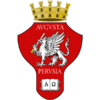Perusia
Perusia
| |
|---|---|
| Borough of Perusia | |
| 𐌅𐌀𐌉𐌔𐌖𐌓𐌀𐌐 transcription(s) | |
| • Romanisation | PARYSIA |
| • Hellenic alphabet | ΠΑΡΥΣΙΑ |
| • Cyrillic alphabet | ПАРУЗИА |
| • Glagolitic script | ⰒⰀⰓⰖⰈⰋⰀ |
| Mottoes: Neoclassical Latin: PERVSIA SVPRĀ OMNIA (Perusia above all) | |
| Anthem: "Giovinezza "Youth" (1922 lyrics) | |
| File:Map of Perugia, Italy.png | |
| Coordinates: 43°06'39.0"N 12°23'15.5"E | |
| Micronation | |
| Voivodeship | |
| Established | 10 March 2021 |
| Founded by | Quintus De Vitaliis |
| Seat | Vīlla Vmbriæ, Via del Cambio |
| Government | |
| • High Burghermaster | Quintus De Vitaliis |
| Demonyms | Perusino (m.), Perusina (f.) PERVSĪNVS (m.), PERVSĪNA (f.) 𐌋𐌀𐌉𐌔𐌖𐌓𐌀𐌐 (m.), 𐌀𐌋𐌀𐌉𐌔𐌖𐌓𐌀𐌐 (f.) |
| Languages | |
| • Official | Italian, Neoclassical Latin, Græcian |
| • Minority | Umbrian |
| • Immigrant | Albanian, Arabic, Hellenic |
| Time zone | UTC+01:15 (Græcian Western Time) |
| • Summer (DST) | UTC+02:15 (Græcian Western Summer Time) |
| Postal code | |
| Area code | +39 |
| Vehicle registration | PE |
The Borough of Perusia (Italian: Borgo di Perusia, pronounced: [ˈbor.ɡo di peˈru.zja]; Neoclassical Latin: BVRGVS PERVSIÆ, pronounced: [ˈbʊr.gʊs pɛˈrʊ.s̠i.äe̯]; Græcian: 𐌅𐌀𐌉𐌔𐌖𐌓𐌀𐌐 𐌍𐌝𐌔𐌖𐌄𐌂, romanised: CEYSⱵN PARYSIAǷ, hellenised: ΓΕΥΣͰΝ ΠΑΡΥΣΙΑϜ, cyrillised: ҐЕУЗЪН ПАРУЗИАЎ, glagolitised: ⰃⰅⰖⰈⰟⰐ ⰒⰀⰓⰖⰈⰋⰀⰫ, pronounced: [ˈgeuzən paˈru.zi.aw]) is one of the boroughs of Græcia, the second-level administrative divisions of the micronation. It was formed in March 2021 AD, located in Perugia, Umbria, Italy.
Name
The Borough of Perusia was named after Perugia, the macronational city that surrounds the borough. For the sake of brevity, the Borough is referred to as Perusia (Italian: Perusia, pronounced: [peˈru.zja]; Neoclassical Latin: PERVSIA, pronounced: [pɛˈrʊ.s̠i.ä]; Græcian: 𐌀𐌉𐌔𐌖𐌓𐌀𐌐, romanised: PARYSIA, hellenised: ΠΑΡΥΣΙΑ, cyrillised: ПАРУЗИА, glagolitised: ⰒⰀⰓⰖⰈⰋⰀ, pronounced: [paˈru.zi.a]). In Umbrian (specifically Perugian), the borough's name is also spelled "Perusia" and pronounced [peˈru.si.ǝ].
The borough incorporates the Latin honorific "Augusta" when there are celebrations. Therefore, "Augusta Perusia" serves as the borough's ceremonial name. It appears on the coat of arms, stylised as "AVGVSTA PERVSIA". By gubernatorial decree, the ceremonial name of the borough can only be incorporated in Latin – therefore, translations in Italian or Græcian are deemed unofficial. If translated, the name would look like this: Sacrosanta Perusia (Italian) and 𐌓𐌄𐌙𐌔𐌀𐌍𐌂𐌀 𐌅𐌀𐌉𐌔𐌖𐌓𐌀𐌐 (PARYSIA ACNASVER [paˈru.zi.a agˈnaz.ver], Græcian).
History
The Borough of Perusia was formed on 10 March 2021 AD, alongside the boroughs of Sarajbosna, Sisypheia, and Vathy.
Government
Current High Burghermaster: Quintus De Vitaliis
The Borough assembly is composed of 10 counselors.
Economy
The Borough of Perusia depends on local consumption and tourism. The borough's area of influence includes many restaurants, cafés, shops, supermarkets and other types of businesses.
Geography
The Borough of Perusia is located entirely within the historical centre of the city of Perugia, accounting for just 150 m². Its area of influence covers a significant portion of the city, beyond its centre, covering a total of 449,92 km².
Demographics
Population
| Population (2023) | Citizens (2023) | Other subjects (2023) |
|---|---|---|
| 168.066 | 2 | 168.064 |
Religion
The vast majority of the people living in the Voivodeship are Catholic Christians (99%), while the rest are atheists and muslims. The patron saint of the Borough is Saint Herculanus, whose feast is celebrated on 7 November.
Language
The official languages of the Borough are Italian, Neoclassical Latin, and Græcian. Italian is the most common of all three, as the vast majority are native Italian speakers – therefore, public announcements are issued in standard Italian. Neoclassical Latin is mostly used by the government itself, in other announcements, papers, laws, etc. Græcian is currently taught and will hopefully be used as a cultural link with the proposed expansion of Græcia in the Italian south. A minority of locals are native speakers of the Umbrian dialect (mostly its Perugian subdialect), while many people understand and occasionally use it. As a result, it was decided that Umbrian will be a recognised and protected minority language. Although not recognised, Albanian, Arabic, and Hellenic are spoken immigrant languages.

